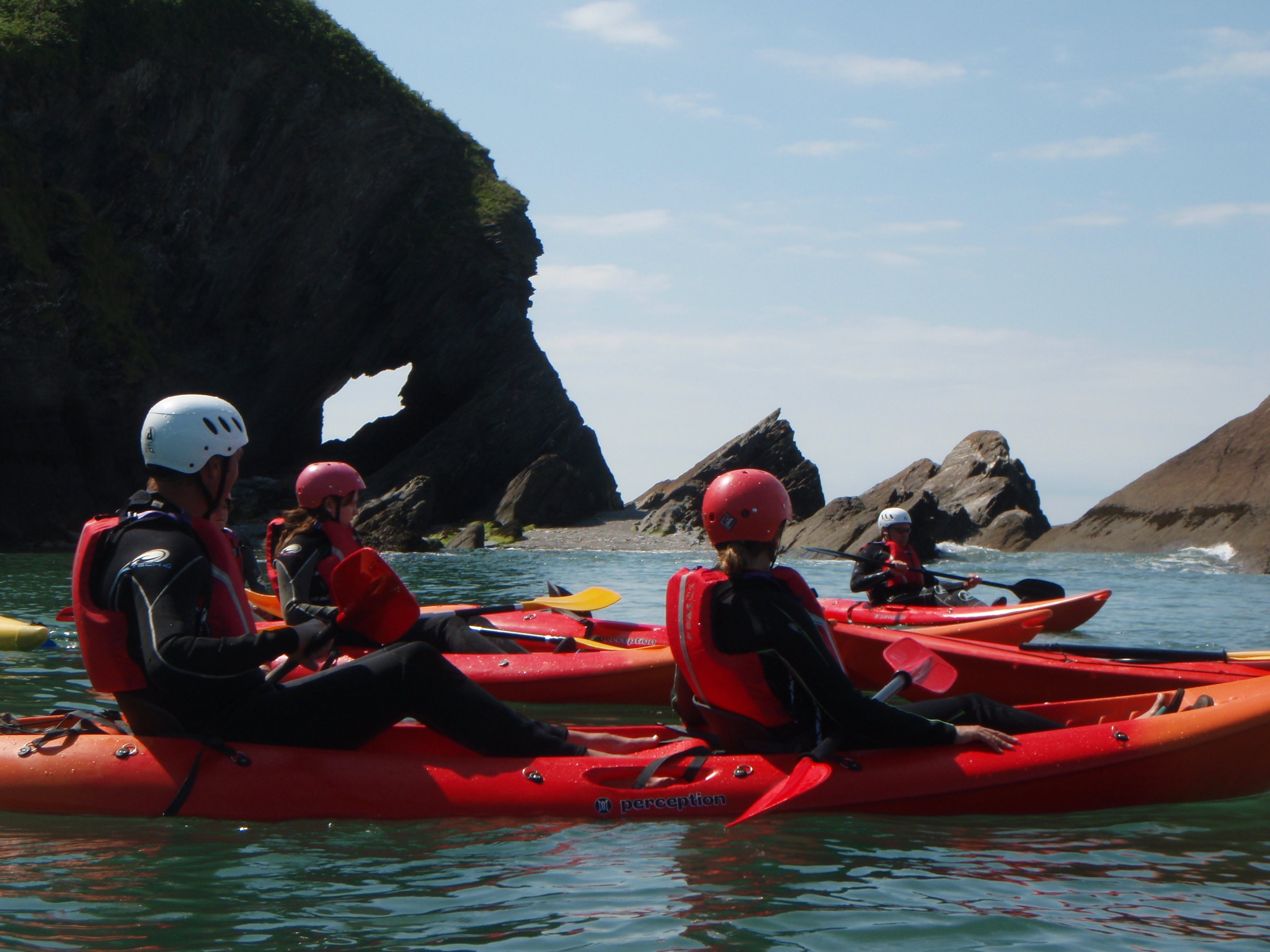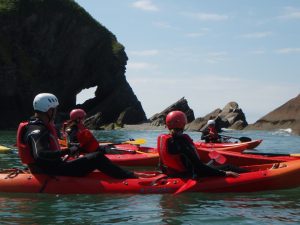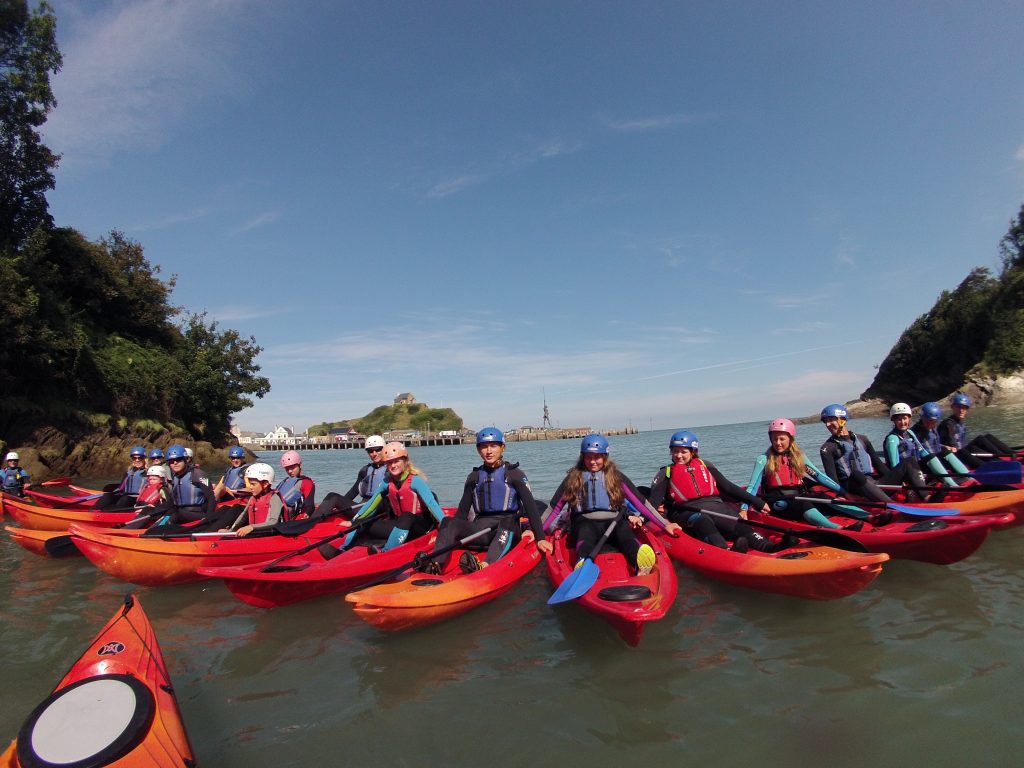
Instead of kayaking on lakes or rivers, a sea kayak is designed to be more stable in the swell of the sea. You get the calm of the open sea or the thrill of kayaking through narrow channels and gulleys as the sea forces water between rocks at the base of cliffs. Sea kayaking allows you to experience the wonder and nature of the sea close up and from a viewpoint that not many people get to see. You get a real sense of freedom when you glide across the swell of the waves exploring the coastline with its many caves, secluded beaches, clear blue waters and breathtaking scenery. The opportunities for wildlife watching abound, because you go far from the madding crowds.
It’s not all about the nature watching. The experience of paddling across the waves under your own power is quite soothing to the soul. One of the great things about a sea kayak is that they are wider than normal kayaks, and designed to be much more stable in the waves. Within ten minutes, a complete beginner can work out how to move about in a sea kayak, so it is good for newcomers and experts alike.
Sea kayaking for beginners
Sea kayaking is readily accessible for beginners, however depending on your fitness and coordination it will be easier for some. Talking to a sea kayak instructor I was told that more and more people struggle with sea kayaks because adults and children are so unfit these days. Paddling can be a bit tiring on the arms if you are not used to doing any form of physical activity.
What to Expect When Sea Kayaking

I have been longing to go sea kayaking for a while. Walking the cliff top coastal paths around the UK, I often sea small groups of people in sea kayaks exploring the cliffs and caves. Whilst on holiday in North Devon, I took the opportunity to try it out.
We went sea kayaking with H2Outdoors in Ilfracombe, Devon. We met at the harbour, where we were given wetsuits, buoyancy aids, helmets and a paddle. The wetsuits were nice clean and dry, which is a rarity for doing watersports. Most times I have been on water adventures, the instructor has only a limited supply of wetsuits which will have been used for the previous session and so you have to put on a damp smelly one. Not at H2Outdoors. The instructors make a point of having enough wetsuits for everyone that are in good condition and looked after. A good start to the kayaking experience.
Safety is a priority, and you are given top class sit on sea kayaks and safety equipment. All of the Instructors are British Canoe Union qualified and first aid trained. Each instructor is equipped with all the necessary safety gear including tow lines, flares, first aid kits, VHF radio, mobile phones and other such equipment required for the conditions and the group.
We were given a safety brief, and shown how to use a paddle efficiently. Then we carried our kayaks from the boathouse down to the harbour’s edge. Some families had opted for tandem kayaks for younger children. Due to the group mainly being families with younger children, the 2 hour session remained within the protection of the inner and outer harbour at Ilfracombe. For stag and hen party groups, able teenagers and adults, sea kayaking sessions go out exploring the coast around North Devon.
Getting into a Sea Kayak
It was quite easy to get into the sea kayaks, mainly because they were sit on top style. From the shore, you just put the front end of the sea kayak in the water so that the front floats and the back still rests on the shore. You then sit on it, and either shuffle the sea kayak forwards into the water, or get a helpful push.
Fun on the Water in a Sea Kayak
We paddled around the harbour and played a few games such as throwing sponges at each other and British Bulldog/Seadog. This helped us practice our paddling and steering skills and improved confidence. The bit I enjoyed most was kayaking in the channels between the rocks and the cliff. The waves were coming around the rocks which made things a bit more challenging but a lot more fun.
We will certainly go sea kayaking again, but aim to go on a half day trip so that we get to go out along the coast.
Sea Kayaking with H2Outdoors

Regardless of your paddling experience, H2Outdoors offers fun filled tailored sessions. H2Outdoors Sea Kayaking sessions are perfect for small or large groups with varied paddling experience as we use sit-on kayaks which are incredibly stable and easy to paddle and all sessions include an introduction to kayaking before taking to the water for some fun. No experience is necessary and all equipment is provided.
If you have some experience and would like to journey a little further along the coast, they have kayaking options for you to choose from ranging from short journeys using sit-on kayaks to half and full day packages using enclosed cockpit sea kayaks. Multi day sea kayaking in North Devon trips are available on request.
H2Outdoor can arrange one-to-one kayaking sessions for you to have our qualified instructor focus solely on you and provide the opportunity to practice rescues and rolls or develop other skills within the kayaking sport.
They also provide other outdoor adventurous activities such as coasteering, high ropes and mountain biking.
Sea kayaking tips
The book Sea Kayak Handling: A Practical Manual, Essential Knowledge for Beginner and Intermediate Paddlers by Doug Cooper is a great compilation of tips on getting started in sea kayaking.
These are a few things I have learned from experience or observation.
- It is less tiring if you are more efficient with your paddling. If you can paddle in a straight line, you use up less energy than trying to correct a zigzag course. Aim to put the paddle into the water as close to the side of the sea kayak as possible.
- If approaching a wave, face your kayak into the wave rather than being side on as it is less likely to tip your sea kayak over.
- Sea kayaks are not intended for use with surf. If you want to try that sort of thing you need to go wave surfing.
- Wear a buoyancy aid. If you fall out of your sea kayak, it is one less thing to think about if you don’t have to put in the effort to keep your head above water.
- Plan ahead and know what the sea and weather conditions are going to be like.
- Tell someone where you are going
- Carry a waterproof dry bag with a mobile phone or radio in it so you can call for help if needed.
- Depending in the weather and time of year, a full body wetsuit will keep you warmer than a short wetsuit.
- Use a paddle leash so that if you let go of your paddle it doesn’t float away.
Sea kayaking equipment
To go sea kayaking you will need:
Places to go Sea Kayaking
The best time to go sea kayaking in Europe is between May and October. In the US, October to May is better for sea kayaking as it is not too hot. August to September is hurricane season and must be avoided.
Sea kayaking in the UK
The UK coastline supports an abundance of wildlife that makes sea kayaking a great experience. The best places to go sea kayaking in the UK are around the Isle of Wight, off the North coast of Cornwall, Devon, and in Scotland.
Alaska sea kayaking
The Kenai Fjords in Alaska offer views of glaciers sliding into the sea. You paddle amongst ice, and can get to see glaciers calving and crashing into the sea. You will definitely need a guide for this trip. The fishing port of Seward is the national park headquarters, and where most sea kayakers go from. You will get to see wildlife such as Sea Eagles, Orca Whales and sea otters. Sunny Cove Sea Kayaking offer trips in Resurrection Bay and the Kenai Fjords.
Greenland sea kayaking
Sea kayaking in the Arctic fjords of Greenland in the summer months gives access to perpetual daylight and passageways through channels in and around the fjords. See glaciers and icebergs in the lands of the Inuit, who invented kayaks. In case you are wondering, kayaks are the watercraft that you usually sit inside and are covered. Canoes are open boats more commonly used in warmer waters.
Sea kayaking in Iceland
Sea kayaking in Iceland is ice free all year round because of the warm currents of the Gulf Stream. You can take this tour as part of a trip to see the volcanoes, geysers and ice of this amazing place.
Sea kayaking in the Ionian Sea, Greece.
The Ionian Sea is the calmest sea around Greece and perfect for sea kayaking. The deep blue Mediterranean waters off the southern tip of Italy and Greece provide wonderful coastlines to explore like those around Crete or Corfu. Whilst exploring the coast and sea caves you might get to see turtles, seals or dolphins.
Sea Kayaking in the Sea of Cortez
Just south of San Diego off the coast of Baja California lies the Sea of Cortez. There are hundreds of unexplored coves, uninhabited islands and estuary mouths to discover. You can see wildlife including sea lions, turtles and plenty of birdlife. One popular route offered by Baja Outdoor Activities is to kayak all the way around the Isla Espiritu Santo near La Paz. You can go on a trip where you and your sea kayak are taken to the island by motorboat. Tours provide camping spots on the island so you can paddle your way around the island camping overnight at stops along the way. After a hard day paddling, turning up to a delicious cooked meal that awaits you is wonderful. Sea kayaking all the way around Isla Espiritu Santo takes between five and seven days.
Sea Kayaking in Phang Nga Bay, Thailand
If you are lucky enough to travel to Thailand, make an effort to try sea kayaking in Phang Nga Bay. Explore hidden sea caves that only a sea kayak can get into. The bay has been used for films such as The Beach, and James Bond movies. Using inflatable sea kayaks, you get to paddle through caves and narrow passageways into the hidden interior of the islands. The water inside the middle is called a hong (room). You are surrounded on all sides by lush forest vegetation hanging from the limestone cliffs. Access to the caves is tidal, so you should use an experienced guide who knows the area.
